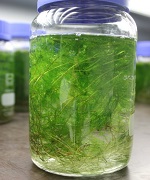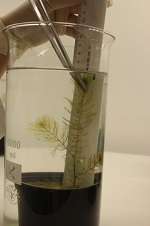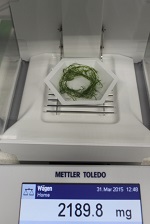- Your Product Type
- Your Study Type
- Aquatic Ecotoxicology
- Aquatic Invertebrates
- OECD 202: Daphnia sp., Acute Immobilisation Test
- OECD 211: Daphnia magna Reproduction Test
- OECD 235: Chironomus sp., Acute Immobilisation Test
- OECD 218/219: Sediment-Water Chironomid Toxicity Test Using Spiked Sediment/Spiked Water
- OECD 233: Sediment-Water Chironomid Life-Cycle Toxicity Test Using Spiked Water or Spiked Sediment
- OECD 225: Sediment-water Lumbriculus Toxicity Test Using Spiked Sediment
- OECD 242: Potamopyrgus antipodarum Reproduction Test
- OECD 243: Lymnaea stagnalis Reproduction Test
- Fish and other vertebrates
- OECD 203: Fish, Acute Toxicity Test
- OECD 215: Fish Juvenile Growth Study
- OECD 212: Fish, Short-term Toxicity Test on Embryo and Sac-fry Stages
- OECD 231: The Amphibian Metamorphosis Assay
- OECD 236: Fish Embryo Acute Toxicity Test
- OECD 210: Fish, Early-life Stage Toxicity Test
- OECD 229 Fish Short Term Reproduction Assay and OECD 230 21-day Fish Assay
- OECD 240 Medaka Extended One Generation Reproduction Test (MEOGRT)
- OECD 248: Xenopus Eleutheroembryonic Thyroid Assay
- OPPTS 850.1500: Fish Life Cycle Toxicity Test
- OÈCD 234 Fish sexual development test
- Aquatic plants
- Analytical Dose Verification
- Aquatic Invertebrates
- Chemistry
- Biodegradation Studies
- Analytical Chemistry Studies and Residues
- Physical-Chemical Properties Studies
- Storage Stability Studies
- OPPTS 830.6302, OPPTS 830.6303,and OPPTS 830.6304: Physical State, Colour and Odor at 20 °C and at 101.3 kPa
- EU A.1: Melting temperature/range
- EU A.2: Boiling temperature
- EU A.3: Relative density (liquids and solids)
- EU A.4: Vapour pressure
- EU A.5: Surface tension
- EU A.9: Flashpoint
- EU A.10: Flammability (solids)
- EU A.12: Flammability (contact with water)
- EU A.13: Pyrophoric properties of solids and liquids
- EU A.16: Relative self-ignition temperature for solids
- EU A.17: Oxidising properties
- OECD 114: Viscosity of Liquids
- Environmental Fate
- Transformation in Soil
- Transformation in Water
- Transformation in Manure
- Adsorption on Soil and Sewage Sludge
- Bioaccumulation and Bioconcentration
- Terrestrial Ecotoxicology
- Non-target Arthropods
- Non-target arthropod testing with the parasitic wasp (Aphidius rhopalosiphi)
- Non-target arthropod testing with the lacewing (Chrysoperla carnea)
- Non-target arthropod testing with the ladybird beetle (Coccinella septempunctata)
- Non-target arthropod testing with the predatory bug (Orius laevigatus)
- Non-target arthropod testing with the predatory mite (Typhlodromus pyri)
- Non-target arthropod testing with the rove beetle (Aleochara bilineata)
- Non-target arthropod testing with the carabid beetle (Poecilus cupreus)
- Non-target arthropod testing with the wolf spider (Pardosa spec.)
- Soil Organisms
- Honey Bees and other Pollinators
- OECD 213/214: Honey bees, Acute Oral and Acute Contact Toxicity Test
- OECD 245: Honey Bee (Apis Mellifera L.), Chronic Oral Toxicity Test (10-Day Feeding)
- OECD 237: Honey Bee Larval Toxicity Test, Single Exposure
- OECD 239: Honey Bee Larval Toxicity Test
- EPPO 170: Honey Bee Field Study – do plant protection products effect honey bee colonies?
- Oomen et al. 1992: Honey Bee Brood Feeding Study
- OECD 75: Honey Bee Brood Test under Semi-field Conditions in Tunnels
- OECD 246/247 Acute Oral and Contact Toxicity to the Bumblebee, Bombus terrestris L.
- Solitary Bee Acute Contact Toxicity Study in the Laboratory (Osmia sp.) Solitary Bee Acute Oral Toxicity Study in the Laboratory (Osmia sp.) (protocols for ringtests with solitary bees recommended by the non-Apis working group)
- SANTE/11956/2016 rev.9 Residue trials for MRL setting in honey
- Non-target plants
- OECD 208: Terrestrial Plant Test - Seedling Emergence and Seedling Growth Test
- OECD 227: Terrestrial Plant Test - Vegetative Vigour Test
- OCSPP 850.4100: Seedling Emergence and Seedling Growth
- OCSPP 850.4150: Vegetative Vigor
- EPPO PP 1/207(2): Efficacy evaluation of plant protection products, Effects on succeeding crops
- Field Studies
- Non-target Arthropods
- Ecological Modelling
- Quality Assurance
- Testing of Potential Endocrine Disruptors
- Aquatic Ecotoxicology
- News
- Company
- Career
- Contact
OECD 239: Water-sediment Myriophyllum spicatum toxicity test
The purpose of this test is to determine the inhibitory effect of the test item on the vegetative growth of the freshwater plant Myriophyllum spicatum. Data for rooted macrophytes may be required in cases where algae and Lemna tests are not sensitive to the mode of action or if partioning to sediment is a concern, leading to exposure via root uptake. M. spicatum will be exposed in a a static or semi-static test to various concentrations of the test item under defined conditions. The inhibition of growth compared to control cultures will be determined over a period of 14 days.
Study Design

Test organisms
Myriophyllum spicatum (Eurasian water milfoil) is a submerged, rooted species which tolerates a wide range of conditions and is found in both static and flowing water bodies. M. spicatum is bred in our own sterile laboratory culture.

Course of the test
For the 7 days pre-rooting phase five healthy shoot tips without flowering shoots at a determined length are planted in pots with artificial sediment and reconstituted water. Without any exposure via water or sediment root development is induced during this phase.
At test start two of the plants are removed from the pots to obtain three largely homogenous individuals for testing. For the control six replicates and for each treatment group three replicates were prepared. One replicate contains generally one pot with three plants.
After application of the test item concentrations in a geomtric series the exposure phase lasts for two weeks. The exposure takes place at a light intensity of 8000-10000 lux with a light:dark ratio of 16:8 h and a temperature of 20 ± 2°C.
At test start and test end the length and biomass of every plant will be determined. For the analytical dose verification the test water and the sediment can be analysed at test initiation and termination.
Generally, the method can be used for other higher plant species as well, e.g. M. aquaticum or Glyceria maxima.
Taylor-made study designs
The exposure of the test item can occur via water or sediment. In exceptional cases the application of the test compound via sediment is possible.
In case of fast degradation of the test item during the exposure phase, periodical water renewals are possible (semi-static test design).
An additional recovery periode after the exposure can be affiliated, to show that the effects are reversible.

Endpoints
The endpoints of the study are growth of total shoot length as well as fresh and dry weight. Based on these parameters NOEC, LOEC and EC50 (EC20, EC10) can be calculated for yield and growth rate. Moreover sublethal effects, such as chlorosis are determined.
Guidelines and literature
-
OECD Guideline 239: Water-Sediment Myriophyllum spicatum Toxicity Test, September 26, 2014
